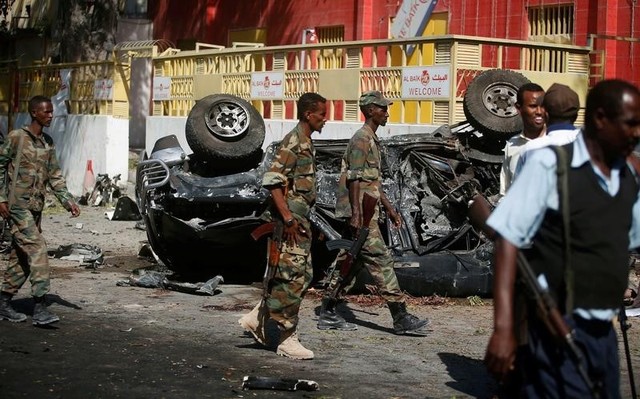Somali militants intensify attacks, death count doubles: experts


By Reuters
Islamist rebels have intensified their attacks in Somalia, detonating larger, more sophisticated devices, bringing in more foreign expertise and doubling the death toll from last year, experts said.
The surge in violence threatens an upcoming presidential vote and the reconstruction of a nation whose population is already leading in droves, swelling a global migrant crisis, analysts and academics told Reuters.
The findings, some of them also outlined in a coming U.N. report, reveal the challenge facing Somalia’s Western-backed government as it battles militants who want to overthrow it and impose their harsh version of sharia, or Islamic law.
Security experts say the plot behind a plane attack in February in particular showed the expanding skillset of al Qaeda-aligned al Shabaab militants and possible links to Islamist insurgencies in the Middle East and other areas.
Improvised explosive devices, or IEDs, killed 470 people in Somalia in the first seven months of 2016, up from just under 200 for all of 2015 and fewer than 50 in 2010, according to figures given to Reuters by Nairobi-based thinktank Sahan Research.
Al Shabaab insurgents detonated five truck bombs in Somalia this year, punching through defensive barriers at military camps and other sites that car bombs would have struggled to penetrate, said Greg Robin, an IED expert at Nairobi-based thinktank Sahan Research. Truck bombs were previously rare.
SHAPED CHARGES
“They have access to large amounts of explosives,” Robin said, adding some bombs were estimated to weigh 400kg or more. Car bombs generally used 100 to 150 kg, he said, since more explosives would weigh down the car and be more easily detected.
Islamists are also increasingly using shaped charges, Robin said, although exact statistics were not available.
The shape directs the blast to a small area, and can sometimes penetrate armour. They are commonly used in Iraq and Afghanistan. Somali officials said shaped charges were used between 20 to 40 times in the past two years.
“The standardisation of IED construction and components seems to reinforce the hypothesis that IEDs are manufactured in one key location and/or by one key network of bomb makers,” Robin wrote in a recent presentation. “The IEDs appear to be distributed from one supply chain.”
The U.N. report seen by Reuters reported on shaped charges and said investigators “obtained information … on the presence of a number of foreign IED trainers with experience gained in conflict zones such as Afghanistan, Iraq, Syria and Yemen.”
The use of pressure plates as triggers was also increasing again, said Robin. Devices triggered by pressure go off when the target is directly above them, making them more accurate than more common radio-controlled devices.
“These IEDs aren’t new in Somalia, but they used to be rare, with fewer than six devices of that type confirmed in all of 2015. Their prevalence suggests new factories for production,” said Gregory Joachim, executive director at Bancroft Global Development, a U.S. organisation training Somali police.
THREAT TO AVIATION
Somali troops and African Union (AU) forces are frequent targets in the country that lies on a vital maritime route. The AU force did not respond to requests for comment.
An attempt to bring down a Daallo Airlines plane flying from Mogadishu to Djibouti in February revealed a complex understanding of bomb-making, aviation and airport security experts said.
The bomb blew a hole in the fuselage but an early detonation at low altitude saved the plane from breaking up midair.
“The threat to aviation is definitely new, more sophisticated,” Bancroft’s Marc Frey said, adding that U.S. authorities concerned by the device’s ability to evade detection circulated images to U.S. airports.
A report prepared by U.N.-appointed experts monitoring Somalia said the bomb was smuggled onto the plane in a briefcase with the help of accomplices at Mogadishu airport and the bomber secured a window seat above the wing and fuel tank.
“The sophistication of the device suggests it may have been constructed with foreign technical assistance,” the U.N. report said. “The same explosion at a higher altitude would have led to a catastrophic accident.”
The original target was a Turkish Airlines flight, but that was cancelled, the U.N. said. Another bomb attempt was foiled at Somalia’s Beledweyne airport.